WW2 rationing in the UK: how it worked
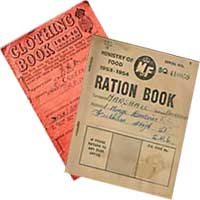
Rationing was one of the main spearheads of the Government Campaign to keep Britain fed in World War Two. It started on the 8th of January 1940, four months after the outbreak of the war and did not end completely until 1954. This page describes how rationing was set up, starting with identity cards and then ration books, and it lists the instructions for using ration books. Highlights are personal recollections of the severity of rationing and what it was like to live with it.
____
By the webmaster: her early recollections and further research with contributions from others who lived at the time
Identity cards: what they were and the procedure for getting them
Identity cards were needed to identify people as bona fide citizens of the UK.
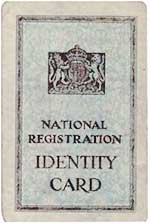
Everybody had to get one. The women - yes, invariably women - collected together the whole family's birth certificates, and took them to their local church hall or school or somewhere similar, rather like the usage of buildings as polling stations today. These were checked and identity cards were issued for every individual in the family.
Ration books: the procedure for getting them
With the family's identity card with them, the women - it was invariably women - returned to the school or church hall to collect the family's ration books. Even the Royal Family had ration books.
The women then took their ration books along to their local grocers and butchers to register with them.
A family had to register at one particular shop for basic foodstuffs like grocers and butchers, and they could only use their ration books there. Fortunately there was no problem with spotting that another shop was selling the same thing cheaper because the Ministry of Food decreed that identical items must cost the same wherever they were bought. This was known as Retail Price Maintenance and there is more about it elsewhere on this website.
Description and types of ration books
A ration book contained coupons, which were very small squares, one for each week. These were for what the Ministry of Food considered to be our basic needs, which were tea, cheese, butter, margarine, bacon, porridge, wheat flakes and shredded wheat, lard, sugar and eggs.
Ration books came in different colours, but the only ones which I remember were buff coloured for adults and blue for older children (between five and 16 years old). I understand that there were also green ones for children under five, pregnant women and nursing mothers, who had first choice of fruit, a daily pint of milk and a double supply of eggs.
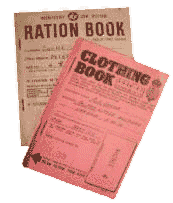
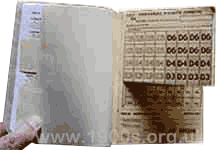
The coupons in ration books were either cut out or crossed out by the shops when rationed items were bought.
Instructions for using ration books
The following instructions are exactly as written inside the ration books.
On the first page
This book is not transferable. It may only be used by or on behalf of the consumer named on the cover.
NATIONAL RATIONING GENERAL RATION BOOK—R.B.I.
How to use this book.
1. The consumer's name and address must be written (in BLOCK LETTERS) in the space provided on the reference leaf (page V).
2. When this book is issued to a child between the ages of 6 and 13 years the declaration on page V should be signed by the parent or guardian, A" being struck out.
3. In order to buy any food that is rationed you must register with a retailer who sells that food.
How to Register with your Retailer.
4. Write the names and addresses of the retailers with whom you intend to register in the spaces inside the front cover. Write our name and address (in BLOCK LETTERS) and the date on the counterfoil at the bottom of the pages of coupons numbered 1, 3, 4, 5 and 6, then take this book to the retailers from whom you mean to buy your butchers' meat, bacon (including ham), butter and margarine, cooking fats including lard and dripping, and sugar. The retailer for each of these foods will write his name and business address on the counterfoil which he will cut off and keep.
Purchases and coupons.
5. Every time you buy rationed food you must hand your ration book to the retailer and he will detach the appropriate coupons. You must not detach coupons yourself. If you do, they will be useless.
6. Coupons not used in the week to which they relate cannot be used later.
Depositing whole pages of coupons with retailers.
7. To save trouble you may tell your retailer to detach a whole page of coupons by cutting 'along the line …...... If he does this he must write the words 'page deposited," the number of the page and the date below his name and address inside the cover.
8. Do not have a page detached if you expect to go away from home on holiday or business. Do not have a page detached if you want to buy cooked meat for lunch or dinner away from home.
Meat meals away from home.
9. Half a meat or bacon coupon may be used to obtain a cooked meal of rationed meat or bacon in a hotel, restaurant, cafe, tea-shop, etc. The half-coupon must be attached from your ration book by the person serving the meal.
Cooked Meat.
10. You may purchase cooked rationed meat at cooked meat shops, but only on surrender of a coupon or half-coupon. The coupon or half-coupon must be detached from your ration book by the person supplying you.
Continued overleaf
Living in a hotel, boarding-house, etc.
11. If you live in a hotel, boarding-house, hostel or similar establishment, do not take your book to a retailer but hand it to the proprietor, manager or other person responsible for the feeding arrangements, who will detach the appropriate coupons and return your book to you when you leave.
Leaving home on holiday or business.
12. Always take this book with you. If you are going to stay in a hotel or boarding-house, hand this book to the management on arrival. If you are staying in lodgings and intend to do your own shopping take this book to the Food Office in the district where you are staying and you will be given an Emergency Card. You can get a new Emergency Card each week you stay up to a total of 6 weeks. Be sure to collect this book from the Food Office before you leave for home.
Removal.13. If you remove to another district and have to change the retailers from whom you buy rationed foods, collect from them any pages from your ration book which you have deposited with them: take your book and any pages which you have collected from your retailers to the Food Office of the district into which you have moved, where arrangements will be made for you to register with retailers in your new district.
Spare Coupons.
14. Do nothing with the pages numbered 7, 8 and 9 until told what to do.
Spare counterfoils.
15. Do nothing with the pages numbered 7, 8 and 9 until told what to do.
Joining the Navy, Army or Air Force.
16. If you join the Navy. Army or Air Force, or are supplied with rations by the Government or other authority, return this book to the Food Office at once.
Leaving Great Britain.
17. If you intend to leave Great Britain for more than 4 weeks you must hand this book to the Immigration Officer when you embark. If you are going abroad for a shorter period you may retain it but you must show it to the Immigration Officer on leaving and on your return.
Air Raids.
18. In the event of your being compelled to leave your home on account of air raids or because you live in a danger zone, take this book with you if possible. In any case go to the nearest Food Office for an Emergency Card on arrival at your destination.
Penalties for misuse.
19. Any false statement, misuse of this book or breach of these instructions renders you liable to a penalty.
Shops and retail outlets selling rationed items
contributed by Peter Johnson, recollections of rationing
Grocers
Each week the women went to their appointed grocer's shop, handed the grocer the families' ration books and he would cut out that week's coupons. These coupons were then sent to the Ministry of Food to be counted. That way they could calculate just how much that grocer's future supplies should be.
Women were given what the grocer had been supplied with. For example, some weeks there would be wheat flakes, other weeks it would be loose porridge.
Biscuits came loose and a weekly allowance per person was announced on the radio and in the newspapers. There was very little choice, you got what was available.
I remember just standing at the grocers with my mother. She handed him the books, he put our rations on the counter and not a word would be spoken. There was no point, as everyone had to have whatever the grocer had that week. There was no alternative.
Butchers
Once families had registered with a butcher, they would wait in queues each week to collect their meat ration. There was little choice. The butcher could only sell what he had been issued with. Again the weekly coupons would be cut out. Meat ration was by price, not weight: For example, you could have a tiny amount of fillet steak if available, which it seldom was, or more of stewing steak.
Bakers
Bread was not rationed during the war although it was afterwards between 1946 and 1948. However, there was only one type, the National Loaf, and it was sold stale. There is more on the page about bread in WW2.
Sweet shops
We did not have to register at any particular shop for sweets, but we still had to take our ration books for the week's tokens to be cut out or crossed out. Throughout the war, the ration was 4 oz of sweets per week per person. My family would go to our local newsagent as this was where there was the largest choice: row upon row of large glass jars of sweets, every colour of the rainbow. Sweets were our big treat of the week and how we children spent our pocket money.
Clothes shops
Each person was entitled to a certain number of clothing coupons which could be used in any clothing shop. Every item of clothing carried a price tag and the number of points needed to obtain it. Clothing coupons could be saved up over the weeks.
Seasonal produce
With very few exceptions, all food was produced within this country, and accordingly varied with the season. The Ministry of Food would announce on the radio and in the newspapers that the week's ration per type and per person was going up or down depending on current supplies.
Food imports from overseas
During the first two years of the war, America did not take part as they were neutral. We British were on our own and our biggest and best friend was Canada. It supplied us with vital supplies from day one and at great risk to its merchant seamen. It was in these first two years of the war that the Germans with their submarines tried to starve this country into submission, and Canada came to our rescue. Today, freedom gives us choice. As we have a choice, we are fussy. Had the Germans managed to invade our country, I hate to think what choice they would have given us. The history books tell what they did in the rest of Europe.
Petrol
Petrol was not on sale for private use, only for work deemed essential for the war. A permit was needed to obtain it. Cars were therefore few and far between. All large cars were confiscated and converted into vans and ambulances. See more on petrol coupons.
Coal
Coal was rationed. See more on coal rationing.
How rationing affected ordinary people
It is only in later years that I have come to appreciate quite how severe the rationing was. I am told that each adult was allowed on average one egg per week, 2 oz of bacon, 2 oz of margarine and 2 oz of tea - although the actual amounts varied week by week according to availability. Butter was reserved for children under five and pregnant and nursing women. Everyone else had margarine - the hard baking sort, not the soft spreads of today. (Various websites give full details of ration allowances in the Second World War and its aftermath which I won't repeat here and which I never knew at the time anyway. If they don't give dates, anyway, they are not to be trusted, as rations did vary.)
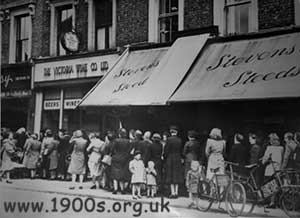
Rationing and shortages meant queues
contributed by Alison Tomlin, family experience
When I asked my mother whether she was frightened that Germany might win the war, she said she didn't think about that at all. She would think only about rationing, how to get the shopping done with all the long queues and what she could cook that night. What seems trivial now was vital then.
Ration books were guarded very carefully. Once my mother left hers on the shop counter of Maynards the sweet shop, and when she went back the assistants denied all knowledge of it. My mother got very upset but I never knew the outcome.
Fortunately, potatoes, other non-imported vegetables and bread were not rationed, although they were often simply not available or rationed informally by shops according to what was in stock.
Eggs were available widely off-ration in rural areas where people could keep hens, but that wasn't practical everywhere.
My mother always said that large families were more able to cope because the women could do more with what they were allowed. "One bit of food works in with another", she used to say.
My friends and I knew nothing of luxury foods, and probably grew up healthier as a result. A glance at my class photo from around the end of the war will confirm that none of us carried any excess weight or were undernourished.

My class photo from 1944 showing that no-one looked undernourished and no-one looked fat, in spite of rationing and shortages.
I have no recollections at all of going without food, clothes or toys, or of being particularly hungry. I suppose that that meant that rationing really did work, with everyone getting what they needed, if not what they wanted. It was the adults who complained about having to go without, because they remembered pre-war times - and almost certainly, without us children realising it, they went without for our sakes.
Try to imagine living with the severity of rationing
contributed by Alison Tomlin, comment
An adult's weekly margarine ration of around 2 oz was just less than a quarter of a standard UK butter pack of 500 grams - and there was no butter.
On average, it would take about four months of an adult's sugar
ration to fill a standard UK kilo bag of sugar.
Perhaps the worse thing was how long it all lasted, even way beyond the end of the war. Post-war rationing was even more severe than wartime rationing.
There were ways to eat 'off-ration' for those who could afford it, but few could afford it often and most would refuse to do anything illegal.
The vegetarian option
My husband remembers his mother registering him as a vegetarian so as to get no meat but extra cheese. Apparently this more than compensated for the loss of meat, and the rest of the family shared their meat and cheese anyway. I suspect that my mother probably registered me as a vegetarian too, but I can't be sure.
| sources | webmaster | contact |
Text and images are copyright
If you can add anything to this page or provide a photo, please contact me.



